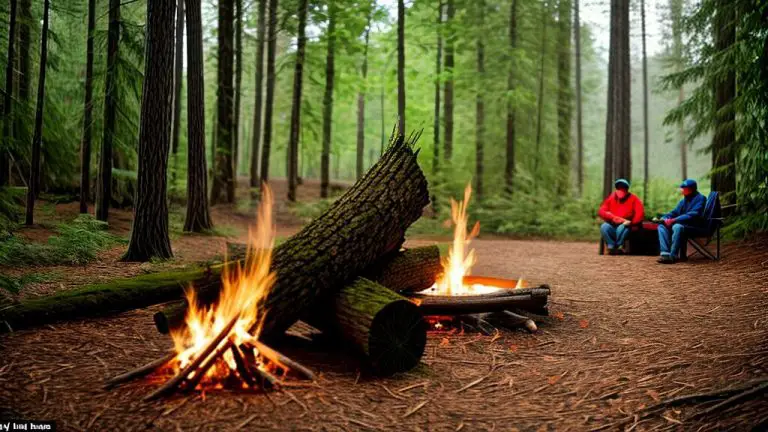Starting a fire is a crucial survival skill, and it can also be an enjoyable activity when camping or spending time outdoors. While lighter fluid can make the process easier, it’s not always available or environmentally friendly. This section will provide expert tips and tricks on starting a fire without lighter fluid, knowing about my eyes getting lighter in color.
Key Takeaways
- Starting a fire without lighter fluid is an eco-friendly and useful skill.
- Natural tinder and kindling, fire bundles, fire pistons, magnifying glasses or Fresnel lenses, bow drill method, flint and steel, and battery and steel wool are all effective fire-starting methods.
- Always prioritize safety when starting a fire in any situation.
Using Natural Tinder and Kindling
Starting a fire without lighter fluid is easy with the help of natural tinder and kindling. This DIY method is eco-friendly, convenient, and perfect for outdoor enthusiasts who like to get back to basics.
The first step is to gather dry leaves, twigs, and small branches from the area surrounding your fire pit. After you’ve collected sufficient material, start arranging them in a small pile. Make sure the pile is not too dense and has enough airflow to allow oxygen in.
Next, use a fire starter or matches to ignite the fuel. Gradually add more fuel as the fire grows. Use the smaller twigs and branches to maintain the fire’s flame, and gradually add larger pieces of wood as needed.
Remember that natural tinder and kindling may be susceptible to humidity or dampness. Therefore, it is best to look for dry material that is easily combustible. With this method, you can easily start a fire without relying on lighter fluid and have a cozy campfire in no time.
Creating a Fire Bundle
If you don’t have access to natural tinder and kindling, creating a fire bundle can effectively start a fire without lighter fluid. Fire bundles are made from highly flammable materials that burn easily, such as cotton balls or dryer lint. Here’s how to create a fire bundle:
- Gather your materials. You will need highly flammable material such as cotton balls or dryer lint, petroleum jelly, and string or rubber bands.
- Rub a small amount of petroleum jelly on your flammable material to enhance its flammability.
- Form a bundle by wrapping the material tightly and securing it with string or rubber bands.
- Ignite one end of the bundle using a fire starter or matches and carefully place it in your fire pit.
A properly constructed fire bundle can burn for several minutes, providing enough time for your kindling to catch fire. Remember that fire bundles can be highly flammable, so always use caution when lighting them and ensure that you have a safe area to place them in. With practice, this method can be an effective way to start a fire without using lighter fluid.
Using Fire Pistons
Fire pistons are a useful tool for starting a fire without matches or lighter fluid. They compile air inside a cylinder, causing the air to heat up and ignite a small piece of fuel, which can then be used to start your fire.
Fire pistons are compact and easy to carry, making them a great alternative for starting a fire in the wilderness. They come in various designs but typically consist of a piston, cylinder, and handle.
To use a fire piston, insert a small piece of fuel or char cloth into the end of the cylinder. Firmly press the piston into the cylinder, compressing the air inside. The heat generated from the compressed air will ignite the fuel, which can then be used to start your fire.
The fire piston method takes practice to master, but it can be a reliable way to start a fire in emergencies. It’s important to note that fire pistons require dry tinder and kindling to be effective. When using a fire piston, ensure you have a good supply of dry materials before starting a fire.
“Fire pistons are an excellent alternative for starting a fire in areas where traditional fire-starting techniques are unavailable.”
Utilizing Magnifying Glasses or Fresnel Lenses
When the sun shines brightly, you can start a fire without lighter fluid using a magnifying glass or a Fresnel lens. This method requires patience and the right weather conditions, but it can be a highly effective fire-starting technique in survival situations.
To use this method, position the lens between the sun and the fuel, focusing the light onto a small spot. Hold it steady until the heat from the focused light ignites the fuel. This may take time and patience, so be prepared to wait for the right conditions.
A Fresnel lens is a flat, thin lens that can be easily carried in a backpack or survival kit. It is commonly used for magnification purposes but is also highly effective for starting a fire without lighter fluid.
Bow Drill Method
The bow drill method is an ancient fire-starting technique that requires some practice but can be highly effective. To use this method, you will need a bow, a spindle, a fireboard, and a socket.
Start by carving a notch in the fireboard and placing a small depression beside it. Insert the spindle into the depression and hold it in place with the socket.
Next, use the bow to rotate the spindle back and forth, creating friction and generating heat. The heat will then ignite the fuel placed in the notch.
Keep rotating the spindle until the ember in the notch starts to glow. Then, transfer the ember to your tinder bundle, blowing on it gently to start your fire.
With a little practice, this method can be mastered, making it a reliable way to start a fire without lighter fluid. Remember to prioritize safety and always have fire extinguishing materials on hand when attempting any fire-starting technique.
Flint and Steel
Flint and steel is a classic fire-starting method used for centuries. This method involves striking a flint against a piece of steel (or another hard, high-carbon material) to create sparks. Catch these sparks onto a char cloth or a highly flammable material to ignite it. Once the char cloth is glowing, transfer it to your tinder bundle to start your fire.
To use this method, hold the flint at an angle to the steel and strike it forcefully to create sparks. Have your char cloth or other tinder ready to catch the sparks and transfer them to your fire bundle. Practice this method before heading out on your camping trip to ensure you have the technique down.
Using Battery and Steel Wool
A 9-volt battery and fine steel wool can be a lifesaver when starting a fire without lighter fluid. Simply touching the battery terminals to the steel wool causes it to heat up and ignite. When using this method, ensure that you have a safe fire-resistant surface to catch any falling embers, and remember to handle the battery with care. This method is especially useful in emergencies when traditional fire-starting supplies are unavailable.
Conclusion
Starting a fire without lighter fluid is a skill that can come in handy when camping, hiking, or in emergencies. By using natural tinder and kindling, creating fire bundles, using fire pistons, exploring magnifying glasses or Fresnel lenses, practicing the bow drill method, using flint and steel, or even a battery and steel wool, you can start a fire without relying on traditional lighter fluid.
It’s important to prioritize safety when starting a fire in any situation. Always ensure that you have a fire-resistant surface and enough water nearby to put out the fire if needed, and never leave a fire unattended. With these expert tips and tricks, you can easily start a fire without lighter fluid and enjoy the great outdoors in an eco-friendly way.

I’m Alfred Davis, and I’m all about lighters. Hailing from the great state of Texas, USA, I’ve cultivated a deep passion for these fascinating gadgets. With years of hands-on experience and a burning curiosity (pun intended), I’ve become an expert in all things related to lighters.
My journey with lighters began as a hobby and quickly became a full-blown obsession. I’ve explored the diverse world of lighters inside and out, from classic Zippo designs to modern plasma arc models. I’ve tested, tinkered with, and even collected rare pieces while learning the intricate mechanics and unique histories behind each one.
Through my writing, I aim to share my knowledge, insights, and reviews to help you make informed decisions about choosing the perfect lighter. Whether you’re a seasoned collector or just looking for a reliable fire source, I’ve got you covered. Join me in unraveling the fascinating realm of lighters right here at LightersInfo, where ignition meets expertise.
Alfred Davis

